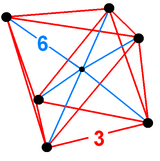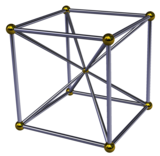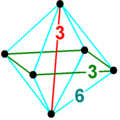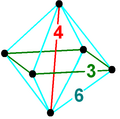|
Octahedral pyramid
In 4-dimensional geometry, the octahedral pyramid is bounded by one octahedron on the base and 8 triangular pyramid cells which meet at the apex. Since an octahedron has a circumradius divided by edge length less than one,[1] the triangular pyramids can be made with regular faces (as regular tetrahedrons) by computing the appropriate height. Having all regular cells, it is a Blind polytope. Two copies can be augmented to make an octahedral bipyramid which is also a Blind polytope. Occurrences of the octahedral pyramidThe regular 16-cell has octahedral pyramids around every vertex, with the octahedron passing through the center of the 16-cell. Therefore placing two regular octahedral pyramids base to base constructs a 16-cell. The 16-cell tessellates 4-dimensional space as the 16-cell honeycomb. Exactly 24 regular octahedral pyramids will fit together around a vertex in four-dimensional space (the apex of each pyramid). This construction yields a 24-cell with octahedral bounding cells, surrounding a central vertex with 24 edge-length long radii. The 4-dimensional content of a unit-edge-length 24-cell is 2, so the content of the regular octahedral pyramid is 1/12. The 24-cell tessellates 4-dimensional space as the 24-cell honeycomb. The octahedral pyramid is the vertex figure for a truncated 5-orthoplex, The graph of the octahedral pyramid is the only possible minimal counterexample to Negami's conjecture, that the connected graphs with planar covers are themselves projective-planar.[2] Example 4-dimensional coordinates, 6 points in first 3 coordinates for cube and 4th dimension for the apex. Other polytopesCubic pyramidThe dual to the octahedral pyramid is a cubic pyramid, seen as a cubic base and 6 square pyramids meeting at an apex. Example 4-dimensional coordinates, 8 points in first 3 coordinates for cube and 4th dimension for the apex. Square-pyramidal pyramid
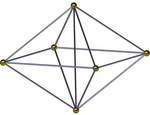
The square-pyramidal pyramid can be distorted into a rectangular-pyramidal pyramid, { } ∨ [{ } × { }] or a rhombic-pyramidal pyramid, { } ∨ [{ } + { }], or other lower symmetry forms. The square-pyramidal pyramid exists as a vertex figure in uniform polytopes of the form Example 4-dimensional coordinates, 2 coordinates for square, and axial points for pyramidal points. References
External links
|
||||||||||||||||||||||||||||||||||||||||||||
Portal di Ensiklopedia Dunia

